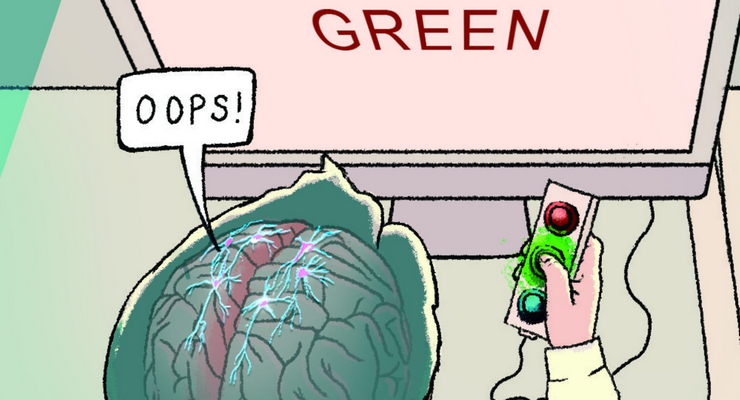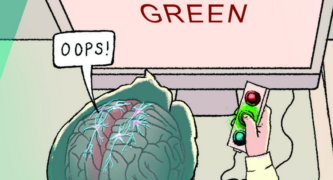
Imagine your garbage disposal is on the fritz. After a few futile attempts to fix it yourself, you reach for your phone. Although you intend to call the plumber, you suddenly realize that you have in fact dialed your mother. Ugh. A quick apology to mom, and you move on to contact the plumber.
We have all experienced something like this, where habit leads to a mistake, and we immediately know we have goofed.
A new Caltech-led study reveals there is a general mechanism deep in the human brain that alerts us almost instantaneously when we make such an error. The neurons involved in that mechanism also retain specific details related to the event, making it possible for other parts of the brain to access that information, and quickly correct the mistake. Even more surprisingly, these same neurons also carried information about mistakes across different tasks, providing a mechanism for learning from mistakes in one task that could be flexibly transferred to perform well on another.
A paper describing the new study appears in the May 6 issue of the journal Science.
The work is the result of a unique, ongoing collaboration between researchers in the laboratories of Ralph Adolphs (PhD ’93), Bren Professor of Psychology, Neuroscience, and Biology at Caltech; and Ueli Rutishauser (PhD ’08), professor of neurosurgery, neurology and biomedical sciences, and Board of Governors Chair in Neurosciences at Cedars-Sinai Medical Center and visiting associate in Biology and Bioengineering at Caltech.
“A central question has been whether our brain learns ways to monitor errors in specific ways in each task, or whether there is an error-monitoring mechanism which can work for many different tasks,” explains Rutishauser. “In this study, we found that the frontal lobe has mechanisms that are domain-general, which means that they can function across different tasks.”
In the study, led by Zhongzheng (Brooks) Fu (PhD ’19), a postdoctoral scholar at Cedars-Sinai and a visitor in neuroscience at Caltech, the scientists were able to monitor the neural activity of individual neurons in 34 patients who had thin electrodes temporarily implanted in their brains (as part of a diagnostic procedure for possible epilepsy surgery). While the patients completed two different tasks in which they could make mistakes, the researchers monitored neurons in their dorsal anterior cingulate cortex (dACC) and the pre-supplementary motor area (pre-SMA), two areas of the medial frontal cortex (MFC), which is a region of the frontal lobe known to be involved in error monitoring.
In the first task, a so-called Stroop test, the subjects were asked to press one of three buttons corresponding to the color of the text shown on a screen. The text would say either “blue,” “red,” or “green,” and could be displayed in any of those colors. So, for example, the word might say “blue” but appear in green text. For most people, the natural first response is to read whatever word appears, in this case “blue.” But the goal for this task is to ignore that natural tendency and to instead press the green button.
In the second task, the Multi Source Interference Task (MSIT), a three-digit number was displayed on a screen and subjects were asked to press a button corresponding to the unique digit included in that number. For example, in the case of “311,” the correct answer would be “3.” This is a particularly difficult example because the unique number appears in the first position and both other digits are ones. These are two factors that push our brains to erroneously select “1.”
Fu points out that these two tasks were chosen because they have different sources of error. In the Stroop test, our natural inclination to read words (rather than look for ink color) leads to mistakes. In the MSIT, it is the spatial distraction that causes slip-ups.
“But if you observe the patterns of the neurons when you make an error in one of the tasks, those patterns look very similar in the other task,” Fu says. “The reason for the error is different, but the brain represents this more abstractly as just a mistake in both cases.”
But what about fixing our mistakes? In order to address an error, we need specific information about the task at hand. The brain cannot fix a mistake with only the general notion that we messed up.
The Caltech-led team found that the neurons involved in detecting errors are, generally, the same neurons that provide the task-specific information needed to fix a mistake or improve at a task. The researchers saw this with the help of new geometric tools they developed to model the activity of the various MFC neurons.
“We view neurons working as a group, like an orchestra,” Fu says. “At any given moment, many neurons are firing, but they fire at different levels.”
To capture the activity of the “orchestra,” they treated each neuron as a coordinate occupying a space with more than three dimensions. Then by plotting each neuron’s activity over time within that high-dimensional space, they were able to trace a trajectory or path representing the way each neuron fired during the tasks.
For simplicity, think of that high-dimensional space as a cake. The researchers found that when they “sliced” the cake one way, the neural signal lost all the details related to the errors in the tasks. This yields a general error signal. By turning the cake 90 degrees and taking a new slice, the signal retained all the specific information about the mistakes, thereby yielding information that a specific mistake was made on the Stroop test, for example.
The MFC can then provide these different signals to various parts of the brain and body: to the amygdala to create an emotional reaction, to other parts of the frontal lobe to allow us to make adjustments and learn from our mistakes, to the hippocampus to form memories, or even to the spinal cord, in a case where an error means that we need to pull back (for example, when we turn on the wrong stove burner and suddenly need to avoid the flame.)
The two tasks in the study require a lot of cognitive control, meaning our brains must wrestle against our more habitual or automatic responses in order to come up with correct answers. The researchers were interested in two different phenomena within that struggle: error and conflict. Error is simply choosing the wrong answer. Conflict is a measure of how much wrestling the brain must do to reject the more automatic response.
“Interestingly, we found that after we win out this internal competition and our intention is carried out, our brain still registers this as a difficult battle,” Fu says. ” There is a late, after-the-fact signal in the brain that tells the individual something like, ‘You succeeded, but wow, that was hard.” This goes against a prominent theory in the field called conflict monitoring theory that says the brain detects conflict on the fly, during the making of a decision.
“We were really surprised to find a prominent representation of conflict after the fact,” Rutishauser adds, noting a majority of the activity in the MFC happens after we have taken action. “That points out the prominent role this area of the brain plays in evaluating what has just happened. It’s almost like a post-action review.”
Looking to the future, Rutishauser says he and his colleagues would like to learn how our brains compute that we have made an error.
“We have shown here that the information is there,” he says. “But we don’t know how it arises or why it can happen so quickly.” They would also like to continue to contribute the knowledge needed to develop treatments for psychiatric diseases such as obsessive-compulsive disorder (OCD), which involve deficiencies in error monitoring.
“The study raises as many open questions as it provides answers,” Adolphs adds. “It also highlights the unique insights we are able to obtain from invasive recordings from these patients.”
The paper is titled, “The geometry of domain-general performance monitoring in the human medial frontal cortex.” Along with Fu, Rutishauser, and Adolphs, additional co-authors on the paper include Danielle Beam, Jeffrey M. Chung, MD, Chrystal M. Reed, MD, and Adam N. Mamelak, MD, of Cedars-Sinai Medical Center.
Funding was provided by the National Institute of Mental Health (NIMH), the Silvio O. Conte Centers for Basic Neuroscience or Translational Mental Health Research, the National Science Foundation, the NIH BRAIN Initiative, and the Simons Foundation Collaboration on the Global Brain. The study was approved by the institutional review boards of Caltech and Cedars-Sinai Medical Center.














 0 comments
0 comments


